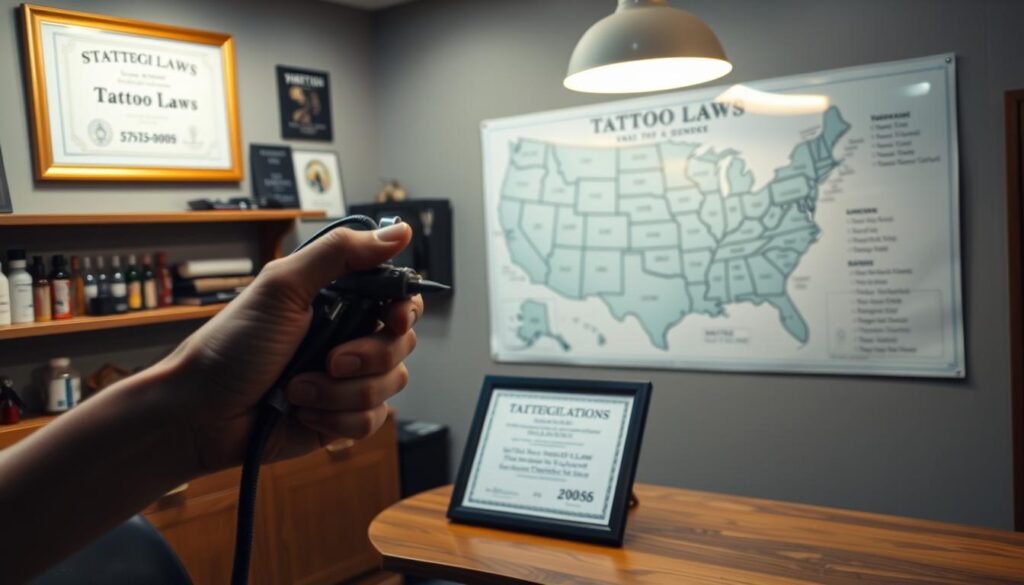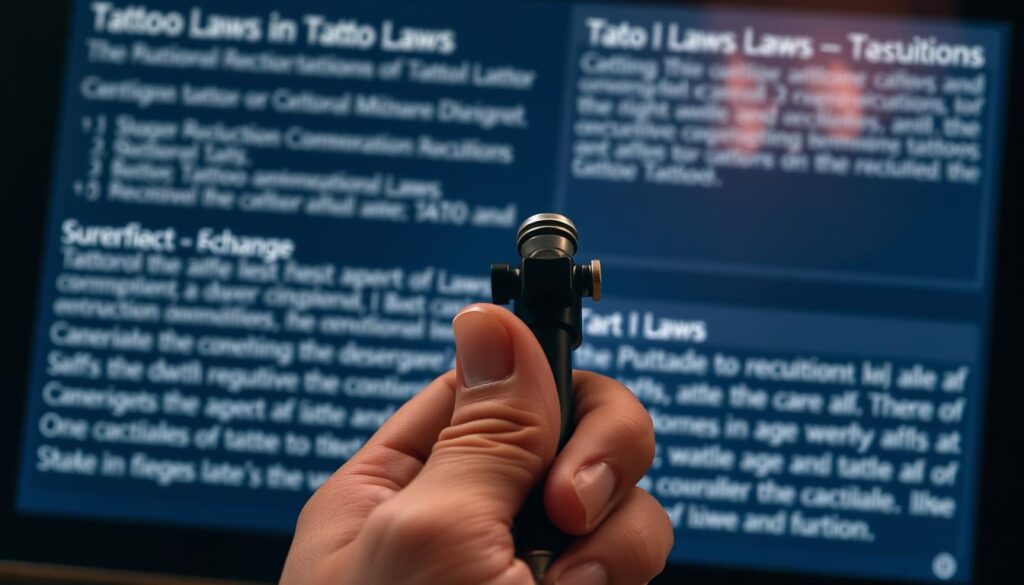
What if the legal age for permanent body art isn’t just about a number? While many assume turning 18 automatically grants the freedom to ink your skin, the reality is far more nuanced. Across the U.S., rules vary dramatically—some states let teens as young as 16 get inked with parental approval, while others strictly enforce an 18+ policy. Why does this matter? Because tattoos aren’t temporary stickers; they’re lifelong commitments etched into your identity.
You might wonder why these laws exist. They’re designed to protect young people from choices that could clash with future goals or evolving perspectives. Think about it: your tastes at 16 rarely match those at 30. States also consider physical development—younger skin heals differently—and emotional readiness for such a permanent decision.
But here’s the twist: even where parental consent is allowed, many artists refuse to tattoo minors. Why? Reputable studios prioritize ethical practices over profit. They know a hasty decision today could lead to regret—or legal trouble—tomorrow.
Key Takeaways
- Legal age requirements for tattoos differ by state, ranging from 16 to 18 years old
- Parental consent laws vary, with some states banning all under-18 tattoos
- Tattoo artists often set stricter rules than state laws to avoid liability
- Age restrictions consider skin maturity and decision-making capacity
- Violating these laws can result in fines for both artists and clients
- Cultural perceptions of tattoos have shifted from rebellion to self-expression
Understanding the Legal Landscape for Tattoos in the United States

Navigating tattoo laws feels like solving a patchwork puzzle. Unlike national policies for driving or voting, permanent body art regulations shift dramatically depending on where you live. The U.S. leaves these decisions to individual states, creating a mix of rules that might surprise you.
Federal vs. State Regulations
No federal law sets a universal minimum age for tattoos. Instead, each state crafts its own standards. Some allow 16-year-olds to ink up with parental approval, while others lock the door until 18. Local cities can add extra layers—like stricter age limits or safety protocols—making research essential before booking an appointment.
Enforcement and Penalties
Breaking these regulations isn’t a slap-on-the-wrist offense. Artists risk losing their licenses or facing criminal charges for underage work. Fines often exceed $1,000 per violation, and studios might get shut down permanently. Even with parental consent in allowed states, many reputable artists still refuse—prioritizing ethics over easy money.
Your best move? Double-check both state and city codes. A quick call to local health departments or trusted studios can prevent costly mistakes. Remember: these laws exist to protect everyone involved, from artists to clients making lifelong decisions.
How Old Do You Have to Be to Get a Tattoo

State lines often determine when skin becomes a canvas for lifelong art. While 18 remains the baseline minimum age in most areas, exceptions exist where younger individuals can access body art with parental involvement. These rules balance personal freedom with protection against impulsive choices.
Understanding the Minimum Age Laws
Eighteen years old serves as the legal threshold in 38 states, matching adulthood recognition. However, seven states permit ink work at 16-17 with notarized parental consent. A few outliers like Iowa and Wisconsin completely ban under-18 tattoos regardless of permissions.
These variations stem from differing views on maturity. Lawmakers recognize that permanent modifications require sound judgment—something that develops at individual paces. Even in consent-allowed states, many studios set higher age limits to avoid liability.
Implications of the Legal Age
Meeting your state’s age requirement unlocks legal autonomy over body art decisions. You gain full responsibility for aftercare, potential infections, and future removal costs. Artists gain protection too—they won’t face fines for serving consenting adults.
But legality doesn’t equal readiness. Skin at 18 still changes texture over decades, affecting ink appearance. Emotional preparedness matters as much as birth certificates. As one artist notes: “Laws tell us when we can tattoo—not when we should.”
State-by-State Overview of Tattoo Age Requirements

Your zip code might determine your ink eligibility more than your birthday. Across America, tattoo laws create a patchwork of rules that surprise even seasoned artists. Let’s explore how regional differences shape access to permanent body art.
Coast-to-Coast Comparisons
Florida and Texas showcase contrasting approaches. The Sunshine State allows 16-year-olds to get inked with notarized parental consent—and a parent must stay during the entire session. Texas offers two paths: full autonomy at 18 or younger with documented guardian approval.
Idaho breaks norms by permitting tattoos at 14 with parental involvement, though most studios avoid this rare exception. Meanwhile, California and New York hold firm at 18 with zero exceptions. These differences highlight why researching local tattoo laws matters before sketching designs.
| State | Minimum Age | Parental Consent | Special Rules |
|---|---|---|---|
| Florida | 16 | Yes | Parent must attend appointment |
| Texas | 18 | Yes* | Consent for under 18 requires notarization |
| Idaho | 14 | Yes | Rarely practiced by studios |
| New York | 18 | No | No exceptions |
| Colorado | 16 | Yes | Mandatory 24-hour waiting period |
Consent Complexity Across Borders
Even when parental consent exists, requirements vary wildly. New Jersey demands medical-grade paperwork, while Michigan bans facial tattoos for minors. Some states require:
- Notarized forms with design details
- Proof of guardianship through birth certificates
- Bans on “visible” tattoos for school attendees
Remember: studios often set stricter policies than state minimums. Always call ahead—your dream design might need more than a parent’s signature to become reality.
Reasons Behind Age Restrictions for Tattoos

Ever wonder why lawmakers care when you mark your skin? These age restrictions exist because permanent body art carries lifelong implications. Three critical factors shape these rules: the unchanging nature of ink, ongoing physical development, and health considerations.
Permanence and Body Development Concerns
Your body isn’t done changing in your teens. A rose tattooed on a 16-year-old’s shoulder might stretch into abstract art by age 25. Skin elasticity and muscle growth can warp designs permanently. Even removal leaves ghostly outlines—a $3,000 reminder of impulsive choices.
Health and Safety Risks
Younger skin heals differently. Immune systems still developing might struggle with infections from unsterile needles or poor aftercare. Studies show 22% of first-timers under 18 skip crucial healing steps like moisturizing or sun protection.
Peer pressure compounds these risks. The prefrontal cortex—your decision-making center—doesn’t fully mature until 25. This biological reality explains why many states set 18 as the baseline for tattoo eligibility. As one dermatologist notes: “Ink today becomes history tomorrow—make sure you’re ready to wear it.”
Legal Consequences of Tattooing Minors

What happens when ink meets underage skin? Both tattoo artists and clients face harsh realities when crossing legal age boundaries. While the temptation to get tattoo without meeting requirements exists, the risks far outweigh temporary satisfaction.
Penalties for Tattoo Artists and Studios
Professionals caught tattooing minors risk their livelihoods. First offenses often bring fines up to $5,000—enough to bankrupt small studios. Repeat violations can lead to license revocation, forcing artists into career changes.
Some states escalate punishments. California treats underage work as misdemeanors, while Texas imposes felony charges for third offenses. Even accidental mistakes in checking IDs can trigger investigations.
Accountability for Minors and Parents
Though teens rarely face charges, their guardians might. Courts can order parents to pay removal costs or civil penalties. In Oregon, families foot the bill for laser processes averaging $300 per session.
Smart studios now use triple verification: photo IDs, notarized forms, and witness signatures. As one tattoo artist explains: “We’re not just drawing—we’re protecting futures.” Your best defense? Wait until you meet your state’s legal age requirements.
Parental Consent: When and How It Applies

Think parental approval guarantees your teen’s tattoo? Think again. While 14 states allow parental consent for under-18 body art, these permissions come with strict conditions. Studios often demand more than a parent’s signature—they want ironclad proof you’ve considered this lifelong decision.
Understanding Consent Limitations
Not all states treat consent equally. In Florida, guardians must attend the entire session and show birth certificates. Colorado adds a 24-hour cooling-off period after paperwork submission. These rules prevent impulsive choices that could haunt families later.
Even when legal, many artists refuse to get tattoo requests from minors. Reputable studios often set higher age limits than state laws—some won’t ink anyone under 21. As one Oregon artist explains: “We’re creating forever art, not temporary stickers.”
Divorced parents face extra hurdles. Six states require both biological guardians’ approval unless custody papers state otherwise. Some mandate court orders if one parent objects. These safeguards ensure no single adult can greenlight permanent changes to a child’s body.
Remember: parental consent doesn’t erase regret risks. Once ink meets skin, laser removal becomes the only escape—a costly and painful process. Before signing forms, families should discuss design meanings, career impacts, and evolving personal styles over decades.
Emotional and Physical Readiness for Permanent Ink
Choosing permanent body art demands more than just meeting age requirements—it requires honest self-reflection. While laws set technical boundaries, your commitment to living with ink for decades matters equally. This decision impacts careers, relationships, and self-image long after the initial excitement fades.
Assessing Your Maturity
Ask yourself: Will this design still resonate in 20 years? Tattoos outlast jobs, friendships, and life phases. Over 40% of people with body art report some regret, often linked to choices made during emotional highs. Peer pressure or fleeting trends shouldn’t drive your decision.
Long-Term Commitment and Removal Realities
Tattoo removal isn’t an easy fix. Each laser session costs $200-$500 and requires 6-12 visits for partial fading. Scarring and discoloration often remain, creating ghost images of past decisions. Even “easy” placements like forearms can interfere with professional dress codes.
Your skin deserves thoughtful stewardship. Before getting tattooed, sit with your design idea for six months. Discuss it with mentors who’ve navigated life’s changes. Remember: commitment to body art means embracing its story—flaws and all—as part of your evolving journey.
